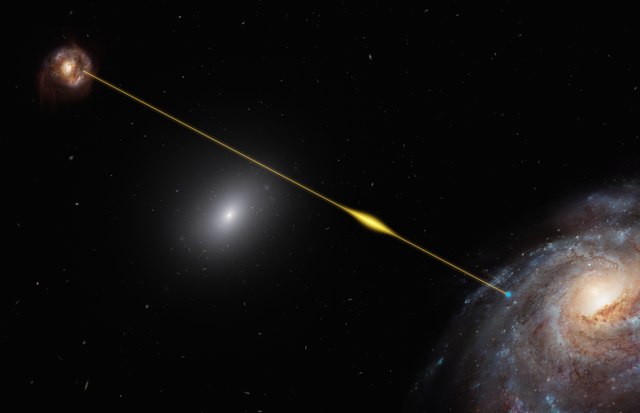Astronomers have detected a mysterious fast radio burst in space with a pattern similar to a heartbeat with a signal estimated to come from a faraway galaxy roughly a billion light-years away.
In a study detailing the findings published in the journal Nature on Wednesday, researchers noted that the exact location and cause of the burst is unknown, but it displays the clearest periodic pattern for a fast radio burst (FRB) found so far.
FRBs are intense, millisecond-long bursts of radio waves in space. The first FRB was discovered in 2007, and since then, hundreds of these quick, cosmic flashes have been detected coming from unspecified, distant points across the universe.
“We don’t know what these explosions are, [but] they are so powerful that we can see them from across the universe,” Daniele Michilli a postdoctoral scholar at MIT’s Kavli Institute for Astrophysics and Space Research noted.
“Imagine a very distant galaxy,” she added. “And sometimes, some huge explosions happen that emit huge blasts of radio waves.”

While monitoring the data as it came in from CHIME, when the burst occurred, Michilli noted that the signal named FRB 20191221A lasted for up to three seconds, which is about a thousand times longer than typical fast radio bursts making it the longest-lasting fast radio burst to date.
In addition, the researchers found that the radio wave bursts repeated every 0.2 seconds, similar to the pattern of a “heartbeat.”
Fast Radio Burst (FRB) source unknown
Just like other FRBs, the source of FRB 20191221A is unknown, but researchers noted that its emissions are similar to a radio pulsar or a magnetar, two types of neutron stars formed after giant stars die and the cores collapse.

Magnetars are neutron stars with incredibly powerful magnetic fields while radio pulsars release radio waves that appear to pulse as the neutron star rotates. Both stellar objects create a signal akin to the flashing beam from a lighthouse.
Michilli said, “We think this new signal could be a magnetar or pulsar on steroids,” as the fast radio burst appears to be more than a million times brighter than these emissions.
FRB 20191221A was first detected in December 2019 by a radio telescope called Canadian Hydrogen Intensity Mapping Experiment, or CHIME, at the Dominion Radio Astrophysical Observatory in British Columbia, Canada.
The team doesn’t know which galaxy FRB 20191221A originates from, but they estimate that it’s about one billion light years away.
Still, Daniele Michilli said, that’s a “very rough estimate” and much remains unknown.





